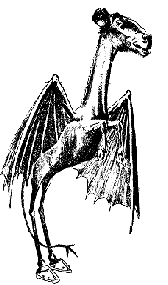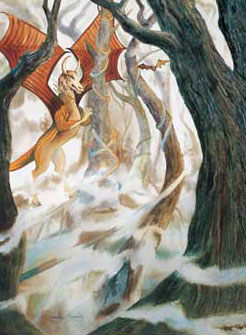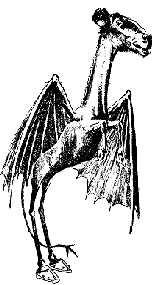
The story of the Jersey Devil is an authentic folk legend. It is as varied as the number of people who claim to have seen or heard him. For over 250 years, tales have circulated about the nocturnal ramblings of a creature emerging from the mists of a lonely desolate marsh. As interest in the supernatural has grown, tales of the Jersey Devil have grown to blend folk belief with South Jersey history. Researched by: Carol Johnson and David Munn, Atlantic County Library
The Devil and the Pines

To understand the legend of the Jersey Devil, you must first understand his birthplace. It is a remote region extending 1700 square miles across southeastern New Jersey. It is actually a giant aquifer with dense stands of white cedar. Inside, the air is calm, still and cool – the shadows heavy. The cedar stands throughout the swamp stain the streams red with tannen. One area of stunted trees is called the Pygmy Forest. While many consider it a barren wilderness, twenty-seven varieties of orchids grow there. In the early days, travel was difficult for the cedar swamps were great obstacles. Some roads are old Indian trails. Others are old stagecoach roads. Some roads are paved, others are sandy. Roads lead to places named Hog Wallow, Double Trouble, Sooy Place and Mary Ann Furnace. These names date back to colonial times when settlers first came to New Jersey. The birthplace of the Jersey Devil is called the Pine Barrens.
The Devil’s Origins
One of the most famous stories tells of a place called Leeds Point. On a stormy night in 1735, a Quaker woman gave birth to a child during a thunderstorm. The room flickered with candlelight. The wind howled. Some believed her to be a sorceress. The impoverished woman, known as Mother Leeds, was believed to have many other children – as many as twelve. Some say the child was born deformed. Some say she cursed the child because of her dire straits. Other accounts say the child was born normal and took on odd characteristics later, characteristics such as an elongated body, winged shoulders, a large horse-like head, cloven feet and a thick tail. According to legend, the child was confined until it made its escape either out the cellar door or up the chimney. The Jersey Devil had been born.

Another story tells of a young Leeds Point girl who had fallen in love with a British soldier. The British had come to the region because the iron furnaces at Batsto were supplying the privateers. In 1778, the British engaged the Americans at the Battle of Chestnut Neck. The townsfolk opposed the match, calling her liaison an act of treason. They cursed the girl. According to legend, when she later gave birth to a child – it became known as the Leeds Devil.
A variation on the tale tells of a young woman who encounters a passing gypsy begging for food. She was frightened and refused. The gypsy cursed her for her refusal. Years later in 1850, with the curse forgotten, when the girl gave birth to her first child – a male – he became a devil and fled into the woods.
Another famous version: In October of 1830, a resident of Vienna, New Jersey, a Mr. John Vliet was entertaining his children with a mask he had made. A mask of a monstrous face. It became a yearly tradition and was adopted by the local townsmen. Its popularity grew and was repeated late in October as parents and children alike put on scary faces and costumes.